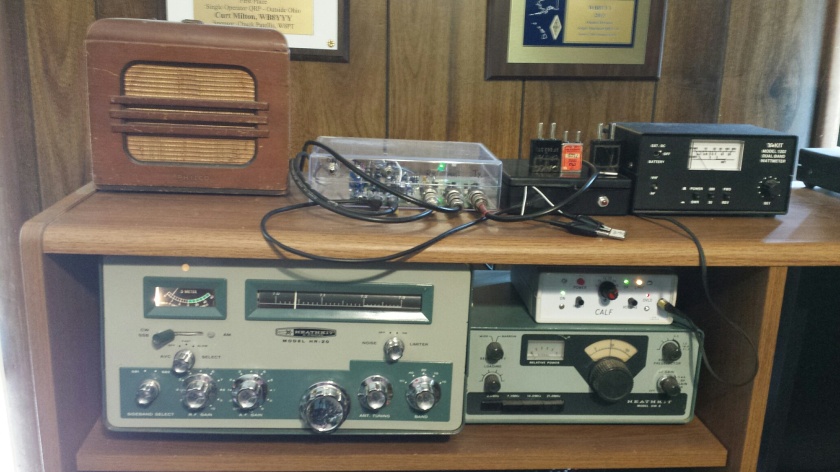
Several parallel thoughts came together for this venture. There was the interest to quickly build something home brew. My original ham band receiver sits here not used in a QSO in 4 decades. This board I once constructed to mate a QRP rig with a receiver into a QSK-worthy combination has been sitting unused. Then there was the interest in building a transmitter with a HEXFET final. Finally, a strange interest in using crystals again to perform oscillation.
The parts had long been gathered, and I ran across a recent design by N5IB that he describes as a tuna tin transmitter line-up followed by a HEXFET stage. I started the build Manhattan style, but before I was done some ugly-construction technique mounting the parts direct on the ground plane got into the mix. I confess I am less about form than function – if I can follow the circuit arrangement. Lacking the same HEXFET, I found the IRF-510 requires a different bias arrangement with more DC bias on the base. Except for the IRF510 PA all the circuit details come from the N5IB schematic, and the PA details are based upon the NB6M mini-boots amplifier.
A few notes about the receiver. It was purchased by my dad for my first ham station in 1976. No markings by the builder of this HR20 Heathkit but it dates from around 1960, a SSB receiver intended for mobile or home use. I made my early QSOs with it before leaving for college, then it has sat with intermittent use since then. Possibly it has the original tubes. Very stable receiver that features a 3 kHz wide crystal filter – no worry a CALF audio filter (subject for a future post) turns it into an effective CW receiver.
A unique board called the Magic Box designed by K8IQY and kitted by 4 State QRP was used to integrate the Tx and Rx. I had thought this board could integrate ANY solid state QRP transmitter with any receiver. Everything was plugged together – 3 coax cables and 4 audio cables between the gear. Nada. Troubleshooting inside the magic box — a hot part was discovered — a IRF-510 used for keying the transmitter. Long story short – the Magic Box presumes minimal current flow on the keying line. The Tuna Tin exciter has the 13.8 volt supply direct on the key – ouch. Fortunately a PNP keying circuit, a la the K7ZOI Ugly Weekender Tx came to mind – the solution was at hand. A few parts landed to further ruin the Manhattan appearance – but succeeded in making the rig.
In the picture above the HR20 is the prominent Heathkit item in the lower left with the illuminated dial. The Magic Box circuit board sits in the clear box with the cables attached to its front panel. To its right in the black box – with only a red push button featured for spotting the transmit frequency in the receiver – is the home brew transmitter. Those are crystals of various kinds sitting on top of the transmitter. Still lacking any crystal sockets the transmitter uses a pair of alligator clips to engage the crystal. The CALF audio filter sits on top of the HW8 (not used in this episode).
Tried to use the rig before and during the Zombie Sprint. I could not raise anyone. The next day – magic – the ions were arranged to allow 2 nice arm-chair copy QSOs with neighboring states – both getting RST 579 and enjoying some nice CW from the HR20 again.
More to come on adding a second band to the home brew transmitter ….